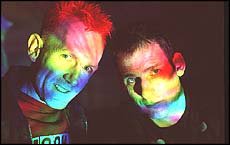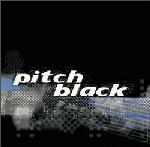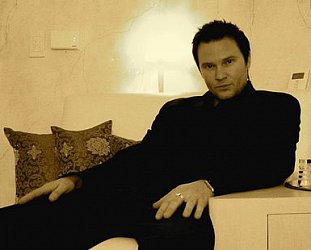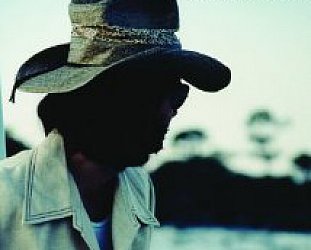Graham Reid | | 5 min read

Lightning sears the walls, neon tubes dance along the screen, mobile tie-dye patterns hover in the mist. And all the while, pulsing, ever-changing electronic music triggers the images, ebbs and flows, and engages the ear as the visuals entrance the eye.
Welcome to the world of Pitch Black, where light and sound collude to infiltrate the brain.
“Why not? We are multi-sensed beings,” says a voice from near the control panel as lightning stabs the wall, then again in disconcerting, hypnotic repetition.
Outside it’s a bright Tuesday and an undifferentiated canopy of blue lies over the city. But in this hermetically sealed, converted office space, Paddy Free and Mike Hodgson, who are Pitch Black, are enclosed in their own world, exploring the boundaries of music and lighting, visual images and video.
The only limit, as the cliche goes, is that of your imagination. And Pitch Black’s collective imagination is very colourful indeed.
Free and Hodgson — with lighting man John Rayner — are running through the show they are taking on the road, preparing to bridge the barrier between DJs with heads bowed over a control panel, and the human appeal of live musicians.
Free pauses from generating images and sounds out of his keyboard. “I prefer a live band to a DJ. With us it’s humans playing machines rather than the other way round. I think we are different to other electronica acts. I always wanted to be in a band and play gigs, as opposed to, say, a 19-year-old today who’s got a software programme on their computer and is making a track they want Sample Gee to play. That’s fine, but it’s a totally different set of aspirations.”
Pitch Black have a clear idea where they are taking their music and make a distinction between their colourful, technologically interactive performances (“every song has a visual reason to exist,” says Hodgson) and that of an album which inhabits a distinctly separate emotional and physical space.
“I like sitting in a recording studio for hours,” says Hodgson, “just getting things right and thinking, ‘Yep, that’s going to live for a long time.’
“A show will only live in people’s memories, it’ll never exist again. You can certainly do things which work in a live environment, but on record they’d be boring after the 10th listen.”
 And so Pitch Black — with 4000 copies
of 98’s Futureproof debut sold and a new album Electronomicon out
this week — are now fine-
tuning their act in preparation for a
national tour which starts in Wellington tonight and finishes in
Auckland on September 16.
And so Pitch Black — with 4000 copies
of 98’s Futureproof debut sold and a new album Electronomicon out
this week — are now fine-
tuning their act in preparation for a
national tour which starts in Wellington tonight and finishes in
Auckland on September 16.
With shows in smaller centres such as Napier and Ohakune, this will be the first time many will see why there has been such a buzz about this duo, which picked up best electronica album for Futureproof at last year’s b.net awards, and also walked off with best live electronica act, acknowledgment of their world-class shows at the Gathering and Big Day Out.
From distinctive music to elaborate interactive audiovisuals, Pitch Black look set for an international breakthrough.
Hodgson speaks of swapping ideas with electronica artists such as Chemical Brothers and Basement Jaxx at Big Day Out shows, and he’s shortly off to London to prepare the ground.
“When we walk in we’ll be seriously on top of our game. We won’t be trying, we’ll be doing. We’ll have three solid years of experimenting live under our belts and two albums. That’s a much better position to be in when you walk into a new country. And we’ll have Kog behind us.”
The successes of the Kog Transmissions label, to which Pitch Black license their work, are paying off. A recent London showcase gig by Kog artists drew favourable responses and Hodgson expects to follow up connections made and friends won through that and their BDO shows here and in Australia.
Pitch Black could easily be the Next Big Thing out of this country, the electronica equivalent to the success Shihad have had in the rock world. And if so, they go trailing enthusiastic reviews for albums and their free-ranging, musically inventive shows.
These long days in this Upper Queen St room of Red Bull, coffee and revolving lights aren’t so much rehearsals of album tracks as them finding the feel of the music and being able to change it to suit the live context.
There’s an improvisational quality as they engage their expensive technology (“about $25,000 for this,” says Free waving his hand over something which looks like the control panel of a space shuttle) but it comes after hours of practice.
“What we’re constantly doing by
refining and playing like this is setting the conditions for
spontaneity,” says Hodgson. “We like being technically ready so
you know when you push a button or move to that pattern it’s all
going to fall into place.
“Sometimes Paddy will play a whole
new skank riff and I’ll pick it up and go another way completely.
It’s about being prepared and able to do that live.”
He moves the mouse, explains how that bit over there interfaces with this bit, how “every song has its own set of protocols.”
It’s time to nod knowingly.
Pitch Black might speak in code best understood by technophiles but the recognition that there’s an audience beyond the flight deck sets them apart in a culture of faceless DJing.
“I’m always wondering whether the
audience is marooned out there,” says Free.
Pitch Black straddle the dance club and
rock circuit, and feel they combine many different styles under a dub
umbrella “so there’s maybe three genres in one track, plus dub,”
says Free.
“We make songs even if they don’t
necessarily follow standard song structure,” says Hodgson.
“Sometimes we’ll drift away from that, but the idea is still at
the core.
“We don’t describe ourselves as dub
because we don’t come from reggae. However, everything we do is
dub-influenced in that it’s a studio process.
“In a world where everyone is
desperate to fit in and find their market, we’re happy to fall
between every single gap. It’s modern music done by creative
people.”
That’s the least of it. The keyboard triggers a loop video of a drummer hammering his kit as a drum pattern comes out of the speakers, images from artist Lisa Reihana flash past, here comes some animation, there’s the lightning ...
But none are random. Each image has “a level of conscious content” and those lightning flashes and maps of the globe make sense when running parallel to Electric Earth off the new album.
Their live show is an electronica night, but with the ambience of a concert.
The tour is a welcome coda to five
months in a windowless box creating Electronomicon — “14 days a
week in the last fortnight,” says Free.
“It’s the longest we’ve spent on
any project so there’s the danger of losing objectivity. I’m
always eliminating the negative and end up simply polishing and
removing blemishes. You wonder whether it’s any good at all because
all you are listening for and hearing are things you don’t like.”
But feedback has already been excellent
— 20 copies sold off the website in the first few hours, one to New
York — and Hodgson encapsulates how they will count the album a
success: “At the end of it, if a person puts it on on Friday and
takes it off on Monday when they go back to work, that’s
successful.”
“Hopefully, live and on record, the
passion Paddy and I put in comes out of those speakers.”
It does — and through those lightning strikes.
For a 2004 interview with Pitch Black go here.







post a comment